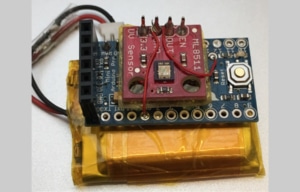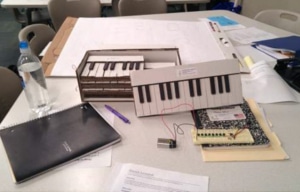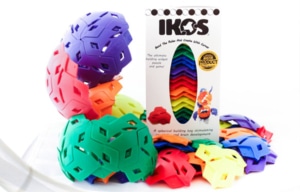In December 2017, Galatea Jewelry filed suit against Swarovski in a California Federal Court alleging infringement of its copyrighted jewelry design entitled TWO IN ONE HEART. The TWO IN ONE HEART design was created in 2009 by Galatea principal Chi Huynh to “capture his vision of love as a union of two individuals, at once both separate and together, with an optical illusion of a single heart comprised of two overlapping hearts formed from the same continuous loop of metal.” Galatea claims that it began selling its TWO OF ONE HEART design in 2010, and that beginning in around January 2016, Swarovski began selling its infringing design. The two designs are depicted below:
|
Galatea
|
Swarovski
|
 |
 |
While the Swarovski design is not identical to the copyrighted Galatea design, Galatea alleges that Swarovski merely (1) horizontally flipped the Galatea design shown above left; (2) removed the existing diamonds; (3) covered a larger portion of the design with crystals; and (4) tapered the points and rounded the edges as follows:

In general, copyright infringement occurs when a copyrighted work is reproduced, distributed, performed, publicly displayed, or made into a derivative work without the permission of the copyright owner. Of primary concern where copyrights are concerned, is whether or not there was “copying” of the work. In theory, if two people create the exact same work completely independent from one another, there can be no copyright infringement. Copying can be proven by direct evidence (an admission, etc.) or circumstantial evidence. Circumstantial evidence of copying requires a showing of “substantial similarity”: (1) access by the alleged infringer to the copyrighted work and (2) similarity of the alleged infringing work to the original copyrighted work. While Galatea does not claim that it had any direct dealings with Swarovski, it does claim that Swarovski had access to the the TWO IN ONE HEART design through Galatea’s catalog, retail jeweler network and website as well as through various trade shows.
Assuming copying can be proven, a plaintiff must next demonstrate that it was the copyrightable elements of their design that were copied. This requires removing the ideas, scenes-a-faire (commonplace themes), facts, and public domain materials from the alleged infringing work. In the affirmative defenses raised by Swarovski in its answer filed in January 2018, the defense of Non-Copyrightable Material is asserted. Presumably, Swarovski is relying upon the scenes-a-faire doctrine, under which the courts will not protect commonplace elements of a work. Sequences of events which necessarily flow from a common theme or commonplace ideas where the elements of the work are indispensable or are standard in the treatment of a certain idea are considered to be scenes-a-faire and are not protectable under copyright law. For example, a court has held that a motion picture about the South Bronx would need to feature drunks, prostitutes, vermin, and derelict cars to be perceived as realistic, and therefore a later film that duplicated these features of an earlier film would not infringe. Scenes-a-faire are still entitled some level of protection, although it is relatively thin. Where scenes-a-faire are concerned, a plaintiff must prove that the infringing design is “virtually identical” to the copyrighted design.
So how does a jewelry designer or artist protect himself or herself against infringers? The first step is to identify what intellectual property protections are available. Jewelry designs, for the most part, are capable of being protected by copyright. Copyright protection attaches upon creation of the work. The designer should clearly mark each piece of jewelry with the appropriate copyright notice to place potential infringers on notice of his/her claim to protection under copyright laws.
In addition, design patent protection may be available for some jewelry designs. Design patents protect the ornamental features and overall design of an invention. Unlike copyrights, infringement of a design patent may be found in the absence of any proof of copying, so long as an ordinary observer who is familiar with the prior art would conclude that the allegedly infringing article is “substantially similar” to the patented design.
A trademark is a word, phrase, symbol, and/or design that identifies and distinguishes the source of the goods of one party from those of others. While they normally would not be used to protect the jewelry design itself, trademarks can be used to distinguish the name of the design, or line of designs from others. For example, Galatea use the trademark Two of One Heart™ to identify its line of jewelry related to the copyright registration.
Once the intellectual property has been properly identified, steps must be taken to protect it. Under U.S. Patent Law, a design patent application must be filed within one year of the first public sale, use or disclosure of the invention or the inventor forfeits the ability to secure patent protection. Trademarks may be protected under common law without the need for a federal registration. However, there are several benefits to securing a federal trademark registration, including nationwide protection and incontestability of the mark after a certain period of time. Lastly, as discussed above, copyright protection begins upon creation of the work, but registration provides the owner with a number of additional benefits, including the right to sue alleged infringers in Federal Court.
Lastly, after protections are secured, the designer must enforce his/her rights. While there is not necessarily a duty to actively seek out potential infringers, a copyright or patent owner who turns a blind eye to infringing activity is in danger of having his or her intellectual property rights diminished or extinguished.
A jewelry designer should seek the advice of a qualified intellectual property attorney to guide him/her through the process of identifying, protecting and enforcing his/her rights. While it may not seem too difficult to do it yourself, simple errors in that process can undermine protection. At Martin IP Law Group, we take the time to work with designers, artists and inventors to build the best plan to protect their valuable property. Contact us today to see how we can help you.
 , an Oakland, California company that was founded in 2014, has invented a breathalyzer machine that can detect recent use of marijuana by a person that may indicate that the person is impaired. With several states having already legalized or de-criminalized recreational use of marijuana, such a device would make our highways and roads safer by finding and punishing people who drive under the influence of marijuana in the same way as those who operate under the influence of alcohol. The availability of such a device may also lead to the rapid legalization of marijuana throughout the country.
, an Oakland, California company that was founded in 2014, has invented a breathalyzer machine that can detect recent use of marijuana by a person that may indicate that the person is impaired. With several states having already legalized or de-criminalized recreational use of marijuana, such a device would make our highways and roads safer by finding and punishing people who drive under the influence of marijuana in the same way as those who operate under the influence of alcohol. The availability of such a device may also lead to the rapid legalization of marijuana throughout the country.

 is the first to offer
is the first to offer 

 On June 19, 2018, nearly 228 years after the
On June 19, 2018, nearly 228 years after the 




